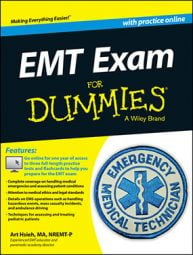The ability to evaluate spinal cord injuries is essential knowledge for the EMT exam. Through much of the history of EMS, practitioners have been taught to immediately apply spinal immobilization to patients if the MOI could have caused a possible spinal cord injury. The fact is, the chance of a spinal cord injury is nearly nonexistent when the patient isn’t complaining of neck or back pain.
You may think, “Well, I’d rather be safe than sorry. Besides, what harm can a backboard do, right?” Unfortunately, being immobilized to a backboard can indeed cause injuries to the patient!
In addition, taking the time to immobilize patients for a low-probability spinal injury while they’re experiencing an airway, breathing, or perfusion injury that requires rapid surgical care causes an unnecessary delay on-scene. Finally, if the patient’s injuries involve airway or breathing, lying supine on a backboard will only compound the problem.
You get the point: Only immobilize when a blunt force MOI suggests a possible spinal injury and you see signs of a possible injury, such as
Spinal pain or tenderness
Neurologic complaint (for example, numbness or motor weakness)
Deformity of the spine
You should also immobilize patients if they exhibit any of the following:
Altered mental status
Drug or alcohol intoxication
Inability to communicate clearly
Another injury so painful that it can distract the patient’s attention from spine pain (distracting injury)
You should not spinal immobilize a patient with penetrating trauma if there is no evidence of spinal injury from the MOI. Spending excessive time on-scene to perform an unnecessary procedure delays transportation to the services of a trauma team, which is what the patient really needs.
This information can be tricky to comprehend. Try the following question to test your understanding.
During a house party, a 29-year-old male falls over the railing of a balcony to the lawn below. He is supine and denies any pain from the fall. You can smell alcohol on his breath, and his speech is slurred. Other than some abrasions to his hands you see no other injuries. You should
(A)immobilize him to a long backboard.
(B)notify the police.
(C)assist him to sit on your gurney.
(D)determine how much he had to drink.
The correct answer is Choice (A). Although the patient denies having any pain or injuries from the fall, there is evidence of an intoxicant that could be masking a trauma condition. Given the MOI, you have to apply spinal immobilization as a precaution.
Compare the preceding question to the following question.
During a house party, a 29-year-old male falls over the railing of a balcony to the lawn below. He is sitting up and denies any pain from the fall. Other than some abrasions to his hands, you see no other injuries. You should
(A)immobilize him to a long backboard.
(B)notify the police.
(C)assist him to sit on your gurney.
(D)determine how much he had to drink.
The correct answer is Choice (C). In this version of the question, there is no evidence of an intoxicant. Even with the MOI, withholding spinal immobilization is appropriate.

